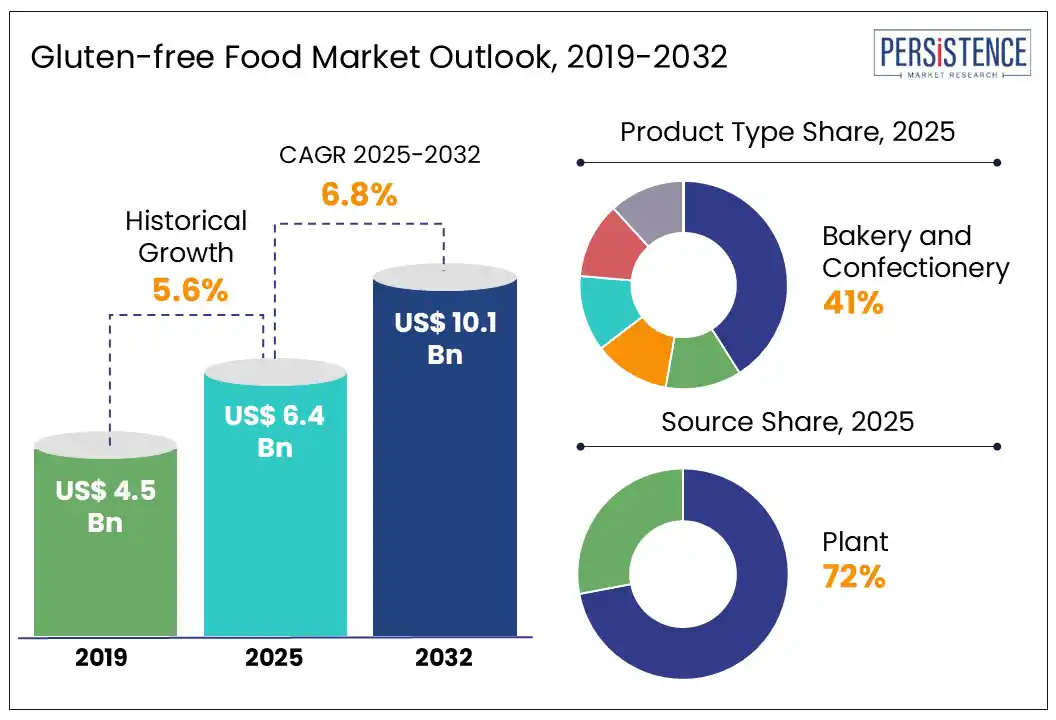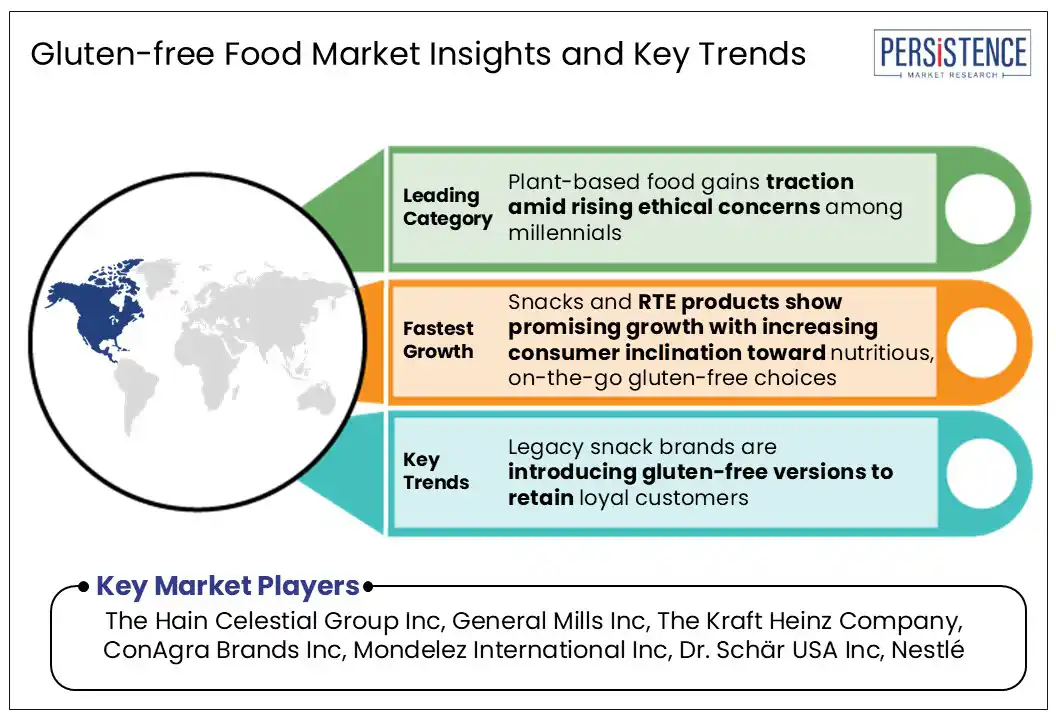ID: PMRREP34937| 198 Pages | 22 Jul 2025 | Format: PDF, Excel, PPT* | Food and Beverages

The global gluten-free food market size is likely to be valued at US$ 6.4 billion in 2025 and expected to reach US$ 10.1 billion by 2032, growing at a CAGR of 6.8% during the forecast period from 2025 to 2032. The gluten-free food market is expanding rapidly as health-aware consumers seek clean-label, gut-friendly alternatives. Evolving dietary preferences, increased celiac awareness, and rising plant-based adoption are reshaping product innovation across bakery, snacks, and ready-to-eat categories.

Key Industry Highlights:
|
Global Market Attribute |
Key Insights |
|
Global Gluten-free Food Market Size (2025E) |
US$ 6.4 Bn |
|
Market Value Forecast (2032F) |
US$ 10.1 Bn |
|
Projected Growth (CAGR 2025 to 2032) |
6.8% |
|
Historical Market Growth (CAGR 2019 to 2024) |
5.6% |
Awareness of gluten intolerance drives the adoption of gluten-free diets as consumers increasingly understand the connection between gluten and digestive issues, autoimmune reactions, and chronic inflammation. According to the Celiac Disease Foundation, celiac disease affects about 1 in 100 people worldwide, yet only 30% of cases are correctly diagnosed. This underdiagnosis highlights the need for greater awareness and access to suitable dietary options. In the United States, government health data shows that nearly one-third of Americans are actively trying to avoid gluten, even without a formal medical diagnosis, reflecting a broader lifestyle change.
The rise of self-diagnosed gluten sensitivity and increased public health awareness have led to a higher demand for gluten-free foods in mainstream retail and foodservice sectors. As consumers focus on gut health, transparency, and allergen-free eating, manufacturers are expanding their range of gluten-free products to meet growing expectations for wellness-oriented, accessible, and clean-label options.
Limited availability of essential ingredients hampers production in the gluten-free market, posing a major challenge for manufacturers trying to meet increasing demand. Core ingredients such as sorghum, millet, quinoa, amaranth, and certified gluten-free oats often face seasonal variations, limited regional cultivation, and export restrictions. Their availability is further limited by strict sourcing standards that require thorough testing to prevent cross-contamination with gluten-containing grains. Small and mid-sized producers are especially impacted by high procurement costs and unreliable supply chains, which can lead to fewer product options or compromised formulas. Additionally, global supply chain disruptions and climate-related agricultural risks affect ingredient availability and price stability. These issues can slow innovation, hinder scalability, and restrict market growth in developing regions.
Brands are increasingly focusing on weight management and digestive health benefits to market their gluten-free products, capitalizing on consumer interest in wellness-driven food choices. Gluten-free foods are often perceived as lighter, easier to digest, and suitable for individuals managing weight or sensitive digestive systems. This perception creates a valuable opportunity for brands to position their offerings beyond medical necessity, appealing to a broader health-conscious audience.
Products formulated with alternative grains such as quinoa, buckwheat, or chia avoid gluten and are also rich in fiber and nutrients that support gut health. An example of this strategy is KIND Snacks, which emphasizes digestive wellness and portion-controlled snacking through its gluten-free granola and bar ranges. By highlighting tangible health outcomes such as reduced bloating or improved metabolism, brands can align their marketing narratives with evolving consumer goals and secure loyalty within the growing better-for-you category.
Plant-based gluten-free food holds a substantial share of 72% as of 2024, driven by rising health consciousness and ethical considerations, particularly among millennials. With the increasing rates of celiac disease and gluten sensitivity, consumers are shifting toward gluten-free diets that emphasize natural, nutrient-dense alternatives. Plant-based options provide a safe and sustainable solution, free from the gluten proteins found in wheat, barley, and rye. Millennials, known for prioritizing ethical food choices and environmental impact are fueling demand for products made from legumes, vegetables, seeds, and whole grains.
These naturally gluten-free ingredients are rich in fiber, vitamins, and antioxidants, promoting overall wellness. Additionally, plant-based gluten-free foods support transparent sourcing and animal welfare, resonating with clean-label expectations. As gluten-free diets move from medical necessity to mainstream preference, plant-based innovations are becoming the cornerstone of gluten-free product development across snacks, baked goods, and ready-to-eat meals.
Snacks and RTE products are expected to grow at a positive CAGR in forecast period, driven by evolving consumption habits and rising demand for convenient, gluten-free options. Consumers are increasingly seeking nutritious, portable foods that align with dietary sensitivities and active lifestyles. The gluten-free snack segment is witnessing rapid innovation, incorporating clean-label ingredients, plant-based formulations, and functional benefits such as added fiber or protein. As per a study by Mondelez International in 2024, 76% of consumers’ snack for a mood boost during the day, highlighting the emotional and practical value of snacking. Gluten-free RTE foods and snacks are becoming essential in daily routines, catering to both health-conscious individuals and those with gluten intolerance. The appeal of instant, safe, and tasty alternatives continues to position this segment as a major contributor to gluten-free market expansion.

North America dominates the global gluten-free food market with a 36% market share as of 2024, driven by increasing awareness of celiac disease and gluten sensitivities. The U.S. leads this trend, with a growing population actively seeking gluten-free solutions as part of a healthier lifestyle. Demand for clean-label, allergen-free products continues to shape purchasing behavior across diverse consumer groups.
Manufacturers are focusing on improving the taste, texture, and nutritional content of gluten-free alternatives, fueling innovation across bakery, snacks, and cereals. These products are now widely available in mainstream supermarkets, convenience stores, and rapidly expanding online platforms. In Canada, the evolving food processing industry is supporting reformulated gluten-free options that align with national wellness goals. As North American consumers increasingly prioritize convenience, ready-to-eat and easy-to-prepare gluten-free meals have gained traction, especially among working adults and families with dietary restrictions.
Europe is expected to achieve a CAGR of 7.4% by 2032, driven by rising health awareness and evolving dietary preferences. One in seven European consumers, particularly from younger generations, incorporate gluten-free products into their diets. Countries like Germany, France, Italy, the UK, and Spain are experiencing strong demand, supported by government-led labeling regulations and food safety standards. Germany leads the region in gluten-free product launches during 2023-2024, with a visible rise in snack and convenience categories. Manufacturers across Europe are investing in R&D to enhance taste, texture, and nutrition. Gluten-free snacks are widely available, reflecting the growing accessibility and normalization of these products. Social media and celebrity endorsements are further accelerating the trend. European consumers are gravitating toward innovative, clean-label solutions that cater to their need for functional, on-the-go, and health-aligned eating habits.
The global gluten-free food market is marked by intense competition, with both multinational corporations and emerging brands vying for consumer attention through product innovation and strategic positioning. Leading companies are heavily investing in research and development to reformulate traditional food offerings into clean-label, gluten-free alternatives, often incorporating functional ingredients like probiotics, superfoods, and plant-based proteins to appeal to the health-conscious segment. Small-scale niche players are gaining traction by offering organic, allergen-free, and transparent-label products that resonate with consumers seeking purity and minimal processing. The shift toward e-commerce and direct-to-consumer channels is enabling wider market penetration, especially among digitally active consumers. As demand for gluten-free convenience grows, brands are emphasizing taste, texture, and nutritional value to differentiate in an increasingly saturated market.
The global gluten-free food market is projected to be valued at US$ 6.4 Bn in 2025.
Growing gluten intolerance awareness is driving interest in Gluten-free Food.
The Global Gluten-free Food market is poised to witness a CAGR of 6.8% between 2025 and 2032.
Brands focus on weight management and digestion benefits to market their products is the key market opportunity.
Major players in the Global Gluten-free Food market include The Hain Celestial Group Inc, General Mills Inc, The Kraft Heinz Company, ConAgra Brands Inc, Mondelez International Inc, Dr. Schär USA Inc, and Nestlé., and others.
|
Report Attributes |
Details |
|
Historical Data/Actuals |
2019 - 2024 |
|
Forecast Period |
2025 - 2032 |
|
Market Analysis |
Value: US$ Bn |
|
Geographical Coverage |
|
|
Segmental Coverage |
|
|
Competitive Analysis |
|
|
Report Highlights |
|
|
Customization and Pricing |
Available upon request |
By Product Type
By Source
By Distribution Channel
By Region
Delivery Timelines
For more information on this report and its delivery timelines please get in touch with our sales team.
About Author